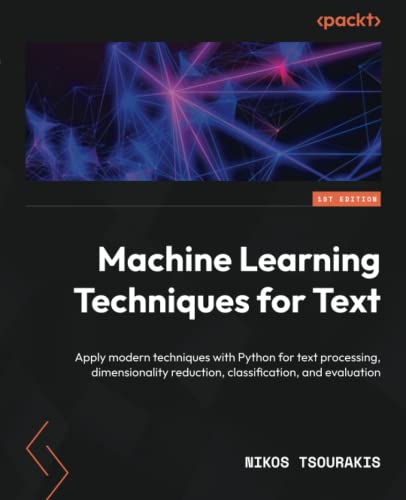Nikos Tsourakis is the author of Machine Learning Techniques for Text, we got the chance to sit down and find out more about his experience of writing with Packt.
Q: What are your specialist tech areas?
Nikos: Speech and Language Technologies, Machine Learning, Software Development
Q: How did you become an author for Packt? Tell us about your journey. What was your motivation for writing this book?
Nikos: Teaching a course on the book’s subject allowed the creation of relevant content through the years. Steadily, its amount increased and became the seed for a book proposal. As an author, I tried unifying this sparse material using a learn-by-example approach while combining theoretical and practical topics. The aim was to provide an academic complement and also target a broader audience of technology practitioners. The high quality of Packt books and the positive experience of other authors made me choose this publisher for my work.
Q: What kind of research did you do, and how long did you spend researching before beginning the book?
Nikos: With abundant material on the same subject, I had to distinguish myself from other authors or online content creators. Indeed, my working experience provided a good knowledge of the landscape, but I had to research the latest resources (blogs, courses, code repositories, etc.) and printed material. As a result, it took me around a month to sort things out and find my value proposition.
Q: Did you face any challenges during the writing process? How did you overcome them?
Nikos: One big challenge is to cope simultaneously with the chapters being at different stages. For instance, while compiling a new chapter, I had to address the editor’s and reviewer’s feedback in previous ones. As this process unfolded, it was common to discover inconsistencies between the chapters (writing style, referring to certain concepts, omitting important explanations, and so forth). In my case, I kept a detailed list of the different issues to address interdependencies and apply revisions in the manuscript adequately.
Q: What’s your take on the technologies discussed in the book? Where do you see these technologies heading in the future?
Nikos: Instead of uniform solutions for the general public, the technologies presented in the book can exploit individual data and provide personalized content. Their output relies on complex processing that is often cryptic, raising suspicion about how users’ personal information is employed. Additionally, there is a lack of identifying malicious incentives behind these systems or sufficient fact-checking. These are already serious concerns, and we urgently need technologies that provide transparency in the decision processes to foster trust.
Q: Why should readers choose this book over others already on the market? How would you differentiate your book from its competition?
Nikos: The book steers a middle path among the various textbooks that present complicated theoretical concepts or focus disproportionately on Python code. Instead, the content is solution-oriented and helps the reader identify at least one practical use for each presented method or technique. In addition, it’s accompanied by programming exercises in the form of Jupyter notebooks to obtain hands-on experience.
Q: What are the key takeaways you want readers to come away with from the book?
Nikos: Understand the fundamental concepts of machine learning for text, explore and preprocess text data, incorporate and fine-tune the models for machine learning, and evaluate the performance of the implemented systems.
Q. What advice would you give to readers learning tech? Do you have any top tips?
Nikos: Find an area that excited you the most and check various job postings to decipher the specific skillset requested. Then, get the most hands-on experience for each skill while publicly demonstrating your work (e.g. in a git repository).
Q. Do you have a blog that readers can follow?
Nikos: Readers can get the latest updates about my thoughts and work on LinkedIn or Twitter (see the links below). More research-oriented people can check my work on Google Scholar: https://scholar.google.com/citations?hl=en&user=cwaZ1KoAAAAJ
Q. How would you describe your author’s journey with Packt? Would you recommend Packt to aspiring authors?
Nikos: I can only recall positive sentiments from my collaboration with the Packt team. Their professionalism and interpersonal interaction allowed me to create a book as I imagined. On the other hand, they provided a large bounding box and direction for my work that prevented unintended ricochets. I am already thinking about how to take a new journey with Packt!
Q. What are your favorite tech journals? How do you keep yourself up to date on tech?
Nikos: Social media is an excellent way to be rapidly informed about new stuff. First, I filter the content displayed based on selected people to avoid excessive noise. Then, I refer to the research publication for an in-depth understanding.
Q. How did you organize, plan, and prioritize your work and write the book?
Nikos: Before committing to writing the book, I compiled a few chapters in advance. This step provided a good approximation of the workload for each chapter. In terms of planning, I decided which fundamental concepts to cover, then grouped each into a different theme. For instance, splitting the data into a training/test set was part of the binary classification theme. Finally, each theme became part of an application topic, from which each chapter took a name—spam detection in the previous example. Of course, in the writing process, I had to revise a few times the different groupings, but my initial planning was a good guide.
Q. What is that one writing tip that you found most crucial and would like to share with aspiring authors?
Nikos: Aim for consistency. As you write the book and get feedback, you will change your mind about many things—for example, the writing style, the layout of tables and images, the amount of detail, and so forth. Keep track of these elements so you can revise the content accordingly, especially in the early chapters.
Q. Would you like to share your social handles? If so, please share.
Nikos: Twitter: @ML4Text Linkedin: www.linkedin.com/in/ntsourakis
You can find Nikos’ book on Amazon by following this link: Please click here









